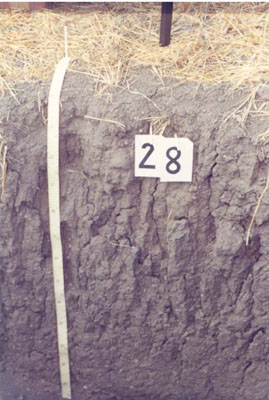IS19
Location: Drung Drung
Australian Soil Classification: Episodic-Epicalcareous, Self-Mulching, Grey VERTOSOL
Northcote Factual Key: Ug5.24
Great Soil Group: grey clay
Soil Type: Horsham Clay.
General Landscape Description: Anastomotic plain.
Geology: Quaternary Shepparton Formation: fluvial silt, sand and minor gravel.
Soil Profile Morphology:
Surface Soil
| A1 | 0-10 cm | Dark grey (10YR4/1); light clay; subplastic; cracking and self-mulching surface condition; weak subangular blocky structure; weak consistence dry; slightly sticky consistence wet; very few (<2%) hard carbonate segregations; pH 6.8; sharp and wavy boundary to: |  IS19 Profile |
| Subsoil | |||
| B21 | 10-25 cm | Dark grey (10YR4/1); light clay; subplastic; moderate very coarse prismatic structure; strong consistence dry; slightly sticky consistence wet; very few (<2%) hard carbonate segregations; pH 8.6. | |
| B22 | 25-60 cm | Dark grey (10YR4/1); medium heavy clay; subplastic; moderate very coarse prismatic structure; weak consistence dry; slightly sticky consistence wet; very few (<2%) hard carbonate segregations; pH 8.9; gradual and smooth boundary to: | |
| B23 | 60-90 cm | Dark grey (10YR4/1); heavy clay; plastic; coarse lenticular structure (slickensides); very few (<2%) hard carbonate segregations; pH 9.2; gradual boundary to: | |
| B31k | 90-130 cm | Greyish brown (10YR5/2); heavy clay; plastic; coarse lenticular structure (slickensides); few (2-10%) hard carbonate segregations; pH 9.3; gradual boundary to: | |
| B32 | 130-195 | Greyish brown (10YR5/2); medium clay; plastic; moderate angular blocky structure; very strong consistence dry; slightly sticky consistence wet; very few (<2%) hard carbonate segregations; pH 9.4. | |
Chemical and Physical Analysis:
Horizon | Sample Depth cm | pH H2O | EC dS/m | Sodium Chloride % | Exchangeable Calcium cmol-/kg | Exchangeable Magnesium cmol-/kg | Exchangeable Potassium cmol-/kg | Exchangeable Sodium cmol-/kg | Total Nitrogen % | Organic Carbon % | Bulk Density | Exchangeable Acidity cmol-/kg | Field Capacity -30okPa | Permanent Wilting Point -1500okPa | Coarse Sand % | Fine Sand % | Silt % | Clay % |
A1 | 0–10 | 6.8 | 0.17 | 0.02 | 2.7 | 6.9 | 0.6 | 2 | 0.05 | 0.56 | 1.07 | 5.1 | 29.9 | 11.7 | 29 | 38 | 3 | 28 |
B21 | 10–25 | 8.6 | 0.12 | 0.01 | 22.9 | 10.3 | 1.7 | 0.8 | 0.05 | 0.54 | 1.43 | 3.6 | 22.4 | 9 | 21 | 9 | 61 | |
B22 | 25–60 | 8.9 | 0.17 | 0.01 | 17 | 15.5 | 1.3 | 1.7 | 0.04 | 0.37 | 1.44 | 5.3 | 23.3 | 8 | 18 | 8 | 63 | |
B23 | 60–90 | 9.2 | 0.24 | 0.03 | 13.4 | 19.8 | 1.5 | 3.3 | 0.03 | 0.3 | 1.33 | 25.5 | 7 | 17 | 9 | 64 | ||
B31k | 90–130 | 9.3 | 0.33 | 0.02 | 11.5 | 20.8 | 1.5 | 5.4 | 0.03 | 0.24 | 1.38 | 26.7 | 8 | 15 | 9 | 65 | ||
B32 | 130–195 | 9.4 | 0.44 | 0.02 | 28.5 | 4 | 13 | 10 | 68 |
Management Considerations:
- Cracking clay profile, possible texture contrast.
- Sodic surface, possible surface sealing/impeded infiltration despite self mulching characteristic.
- High fine sand content of surface (possible windblown inclusions).
- High calcium levels in upper subsoil, high magnesium levels in lower subsoil.
- Sodic subsoil below 60 cm, increasing with depth.
- Landform element, plain; slow site drainage, unless near drainage line.
Profile Described By: John Martin, Nabil Badawy, Ron Cawood, Geoff Pope, John Galea, John Turner (1970).


